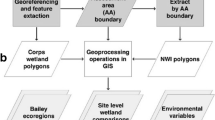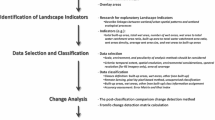Abstract
Wetland mitigation is frequently required to compensate for unavoidable impacts to wetlands. Site conditions and landscape context are critical factors influencing the functions that created wetlands perform. We developed a spatial model and used a geographic information system (GIS) to identify suitable locations for wetland mitigation sites. The model used six variables to characterize site conditions: hydrology, soils, historic condition, vegetation cover, adjacent vegetation, and land use. For each variable, a set of suitability scores was developed that indicated the wetland establishment potential for different variable states. Composite suitability scores for individual points on the landscape were determined from the weighted geometric mean of suitability scores for each variable at each point. These composite scores were grouped into five classes and mapped as a wetland mitigation suitability surface with a GIS. Sites with high suitability scores were further evaluated using information on the feasibility of site modification and project cost. This modeling approach could be adapted by planners for use in identifying the suitability of locations as wetland mitigation sites at any site or region.


Similar content being viewed by others
Literature Cited
S. M. J. Baban K. Wan-Yusof (2003) ArticleTitleModeling optimum sites for locating reservoirs in tropical environments Water Resources Management 17 1–17 Occurrence Handle10.1023/A:1023066705226
B. L. Bedford (1996) ArticleTitleThe need to define hydrologic equivalence at the landscape scale for freshwater wetland mitigation Ecological Applications 6 57–68
M. Brinson (1993) A hydrogeomorphic classification for wetlands. Wetlands Research Program Technical Report WRP-DE-4. US Army Corps of Engineers Waterways Experiment Station Vicksburg, Mississippi
S. C. Brown P. L. M. Veneman (2001) ArticleTitleEffectiveness of compensatory wetland mitigation in Massachusetts, USA Wetlands 21 508–518
V. J. Burke J. W. Gibbons (1995) ArticleTitleTerrestrial buffer zones and wetland conservation: A case study of freshwater turtles in a Carolina bay Conservation Biology 9 1365–1369 Occurrence Handle10.1046/j.1523-1739.1995.09061365.x
L. M. Cowardin V. Carter F. C. Golet E. T. LaRoe (1979) Classification of wetlands and deepwater habitats of the United States. FWS/OBS-79/31. US Department of the Interior US Fish and Wildlife Service, Government Printing Office Washington, DC
M. M. Davis (1994) ArticleTitleDecision sequence for functional wetland restoration Water, Air, and Soil Pollution 77(3–4) 497–511
DuPage County Department of Development and Environmental Concerns. 1999. Data sheet. February.
J. G. Ehrenfeld J. P. Schneider (1993) ArticleTitleResponses of forested wetland vegetation to perturbations of water chemistry and hydrology Wetlands 13 122–129
Gazdaca, M. 2000. DuPage County wetland banks summary, data summary provided by M. Gazdaca, DuPage County Department of Development and Environmental Concerns.
Interagency Workgroup on Wetland Restoration. Undated. An introduction and users guide to wetland restoration, creation, and enhancement. Developed by the Interagency Workgroup on Wetland Restoration: National Oceanic and Atmospheric Administration, Environmental Protection Agency, Army Corps of Engineers, Fish and Wildlife Service, and Natural Resources Conservation Service.
E. Jaworski C. N. Raphael (1979) Historical changes in natural diversity of fresh water wetlands, glaciated region of northern United States P.E. Greeson J.R. Clark (Eds) Wetland functions and values: The start of our understanding: proceedings of the National Symposium on Wetlands, 7–10 November, 1978 Lake Buena Vista, Florida. American Water Resources Association Minneapolis, Minnesota 545–557
Kentula, M.E., Brooks, R.P., Gwin, S.E., Holland, C.C., Sherman, A.D., Stifenos, J.C. 1992. Wetlands: an approach to improving decision making in wetland restoration and creation. Island Press, Washington, D.C.
W. L. Kruczynski (1990) Options to be considered in preparation and evaluation of mitigation plans J.A. Kusler M.E. Kentula (Eds) Wetland creation and restoration: The status of the science Island Press Washington, DC 555–570
J. A. Kusler M. E. Kentula (1990) Executive summary J.A. Kusler M.E. Kentula (Eds) Wetland creation and restoration: The status of the science Island Press Washington, DC xvii–xxv
Lampa, W. Undated. The phoenix land, the natural history of DuPage County. The Forest Preserve District of DuPage County
D. R. Mapes (1979) Soil survey of DuPage and part of Cook Counties, Illinois US Department of Agriculture, Soil Conservation Service Washington, DC
A. D. Marble (1992) A guide to wetland functional design Lewis Publishers Boca Raton, Florida
W. J. Mitsch J. G. Gosselink (2000) Wetlands. 3rd ed John Wiley and Sons, Inc New York
W. J. Mitsch R. F. Wilson (1996) ArticleTitleImproving the success of wetland creation and restoration with know-how, time, and self-design Ecological Applications 6 77–83 Occurrence Handle2001g:20074 Occurrence Handle0967.20033
InstitutionalAuthorNameNRC (National Research Council) (1995) Wetlands: Characteristics and boundaries National Academy Press Washington, DC
InstitutionalAuthorNameNRC (National Research Council) (2001) Compensating for wetland losses under the Clean Water Act National Academy Press Washington, DC
W. A. Niering (1990) Vegetation dynamics in relation to wetland creation J.A. Kusler M.E. Kentula (Eds) Wetland creation and restoration: The status of the science Island Press Washington, DC 479–486
L. Palmeri M. Trepel (2002) ArticleTitleA GIS-based score system for siting and sizing of created or restored wetlands: Two case studies Water Resources Management 16 307–328 Occurrence Handle10.1023/A:1021947026234
R. Pastorok A. MacDonald (1996) Ecological planning process for restoration projects D. Yozzo J. Titre J. Sexton (Eds) Planning and evaluating restoration of aquatic habitats from an ecological perspective IWR Report 96-EL-4, US Army Corps of Engineers, Institute for Water Resources Alexandria, Virginia
S. M. Pearson (1994) ArticleTitleLandscape-level processes and wetland conservation in the southern Appalachian mountains Water, Air, and Soil Pollution 77(3–4) 321–332
J. E. Perry T. A., Jr Barnard J. G. Bradshaw C. T. Friedrichs K. J. Havens P. A. Mason W. I. III Priest G. M. Silberhorn (2001) ArticleTitleCreating tidal salt marshes in the Chesapeake Bay Journal of Coastal Research 27 170–191
M. S. Richardson R. C. Gatti (1999) ArticleTitlePrioritizing wetland restoration activity within a Wisconsin watershed using GIS modeling Journal of Soil and Water Conservation 54 537–542
InstitutionalAuthorNameUSACE (Army Corps of Engineers) (1987) Corps of Engineers wetland delineation manual. Technical Report Y-87-1 US Army Engineer Waterways Experiment Station Vicksburg, Mississippi
USACE (Army Corps of Engineers). 1998. Informational notice: mitigation guidelines and requirements. Chicago District, Chicago, IL, April 30.
USACE (Army Corps of Engineers). 2001. Guidance for the establishment and maintenance of compensatory mitigation projects under the Corps regulatory program pursuant to Section 404 (a) of the Clean Water Act and Section 10 of the River and Harbors Act of 1899. Regulatory Guidance Letter, October 31.
InstitutionalAuthorNameUSFWS (US Fish and Wildlife Service) (1980a) Habitat as a basis for environmental assessment. Ecological Services Manual 101. US Department of the Interior, US Fish and Wildlife Service Government Printing Office Washington, DC
InstitutionalAuthorNameUSFWS (US Fish and Wildlife Service) (1980b) Habitat evaluation procedures (HEP). Ecological Services Manual 102. US Department of the Interior, US Fish and Wildlife Service Government Printing Office Washington, DC
InstitutionalAuthorNameUSFWS (US Fish and Wildlife Service) (1981) Standards for the development of suitability index models. Ecological Services Manual 103. US Department of the Interior, US Fish and Wildlife Service Government Printing Office Washington, DC
Van Lonkhuyzen, R. A., and K. E. LaGory. 1994. Wetlands of Argonne National Laboratory–East, DuPage County, Illinois. Report ANL/EAD/TM-12, Argonne National Laboratory, Argonne, Illinois.
G. Vivian-Smith (2001) Developing a framework for restoration J.B. Zedler (Eds) Handbook for restoring tidal wetlands CRC Press Boca Raton, Florida 39–88
Wayne, C. 2003. Suitability analysis with raster data. ArcUser April–June: 6(2): 54–57; July–September: 2003, 6(3): 42–46
M. P. Weinstein J. M. Teal J. H. Balletto K. A. Strait (2001) ArticleTitleRestoration principles emerging from one of the world’s largest tidal marsh restoration projects Wetlands Ecology and Management 9 387–407 Occurrence Handle10.1023/A:1012058713910
White, D., S. Fennessy, and A. Engelmann. 1998. The Cuyahoga watershed demonstration project for the identification of wetland restoration sites. Ohio EPA final report to the US Environmental Protection Agency — Region V; available at www.epa.state.oh.us/dsw/gis/cuyahoga/demo.html.
Williams, K. B. 2002. The potential wetland restoration and enhancement site identification procedure: a geographic information system for targeting wetland restoration and enhancement. North Carolina Division of Coastal Management, Department of Environment and Natural Resources
Acknowledgments
This work was supported by the US Department of Energy, Chicago Operations Office, under contract W-31-109-Eng-38. We thank Mark Kamiya for his support for this study and reviews of project results. We gratefully acknowledge John Hayse and John DePue for helpful reviews of a draft of this article.
Author information
Authors and Affiliations
Rights and permissions
About this article
Cite this article
Van Lonkhuyzen, R., LaGory, K. & Kuiper, J. Modeling the Suitability of Potential Wetland Mitigation Sites with a Geographic Information System. Environmental Management 33, 368–375 (2004). https://doi.org/10.1007/s00267-003-3017-3
Published:
Issue Date:
DOI: https://doi.org/10.1007/s00267-003-3017-3




